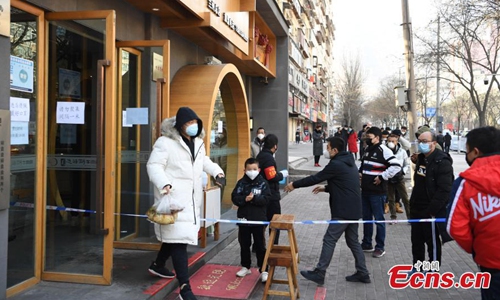SOURCE / INDUSTRIES
Recovery of dining-in shows Chinese consumer spending revival

Customers eat noodles in a restaurant in Lanzhou, Northwest China's Gansu province. Photo: cnsphotos
As dine-in services gradually recover in restaurants across Chinese cities, foodies are eating with friends and families by ones and twos in the restaurants, showing a straw in the wind that Chinese consumer spending is reviving.Diantaixiang, a popular Chongqing-hotpot chain restaurant, resumed the dine-in service in its Dongjiangwan branch in Shanghai on February 11.
According to a person in charge in the restaurant surnamed Liu, about 70 to 80 people come to eat in per day after having their body temperatures measured and showing a "green" health QR code on their smartphone - a pass to go to public places in China.
"Many people are tired of staying home all day," Liu told the Global Times, noting the restaurant must restrict the visitor flow every day.
Shanghai resident Sherry went to Diantaixiang at the People's Square branch on February 22 and said the restaurant was packed.
"Many restaurants in Shanghai resumed dine-in services," Sherry told the Global Times, giving the credit to satisfactory epidemic control and prevention work in Shanghai.
"I just miss the happy feeling of having a meal with my friends," Sherry said, adding the epidemic situation is very clear now and people should not be over worried.
However, large chain restaurants are still on the alert. Popular hot pot restaurant Haidilao told the Global Times on Wednesday the company has not resumed dine-in service, but it has launched delivery services in 86 cities since February 15.
"When customers pick up the food at designated places, our deliverymen will keep a distance of two to three meters from the customer to finish the 'no contact' delivery," the company said in an announcement sent to the Global Times.
For fast food chain Home Original Chicken, about 75 percent of its 800 branches have resumed delivery service and have seen rising orders, the company told the Global Times.
"The sign of a consumption recovery is very obvious in the catering industry… and pent-up consumption will first appear in the industry once the epidemic is fully controlled," Qin Chao, CEO of professional catering media China Restaurants Insider, told the Global Times.
Among the restaurants that have resumed dine-in services across China, the number in southern China surpassed that in the north because epidemic control and production resumption measures are stricter in northern areas, Qin noted, citing South China's Guangdong Province and East China's Zhejiang Province, which resumed local production at fast speed.
According to Qin, restaurants in China have seen 20 to 30 percent revenue growth in February compared with January. He expected a full industry recovery in early or mid-April.
On February 20, Guangdong published a guideline on the local catering industry's recovery. Guangzhou Taotaoju recovered operations on February 21 but halted operations at the end of the day due to a large number of diners.
According to a survey carried out by the China Hospitality Association from February 21 to 23, 73 percent of the 309 surveyed Chinese restaurants stopped operations and consumer flows dropped by 91.52 percent year-on-year.
The average daily loss for each restaurant was 303,500 yuan ($43,796) and 84.54 percent of the surveyed restaurants reported daily losses of 126,000 yuan.

